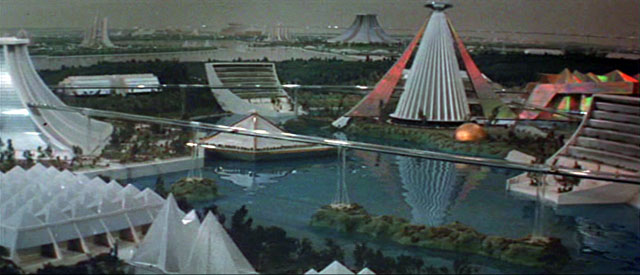Though I am sticking with the basic premise found in the Mutant Future role-playing game, I like to add my own spin (as all Game Masters/Mutant Lords should). Following are a few such touches:
Wilderness (The Unnatural Earth)
"The clearest way into the Universe is through a forest wilderness." -John Muir
The Earth of the Atomic Dawn is a terrible and strange place, haunted by monsters and hostile towards mankind. Animals and plant genetically engineered as food sources and organ donors have mutated rapidly into new and terrible new forms. This along with new diseases and creatures introduced by alien beings has created a brutal new order.
The world itself is hotter and wetter than it is in our age, with increased rainfall worldwide. With this comes riotous growing seasons as well as numerous new diseases and room for large fauna. Creatures considered as mere pests in our age such as insects and rats, are now big, nasty predators with little fear of man or mutant.
The seas are teeming with mutated life and wracked with fierce storms, as rising sea levels have created vast shallows that were once the land. These shallows are covered in dense kelp jungles and haunted by monstrous mutant creatures.
Civilization
"I do not believe that civilization will be wiped out in a war fought with the atomic bomb. Perhaps two-thirds of the people of the earth will be killed." -Albert Einstein
Civilization lives on a knifes edge in the setting, with at best feudal governments and a technology level somewhere between the middle ages and Wild West (1800s). Superstition is widespread, with a deep-rooted belief in spirits, ghosts and witchcraft. Religion of one form or another is central to most communities, and takes many forms (to be detailed later). Holy men and women typically fill the role of educator, adviser and healer. Local variants of all sorts can of-course be found.
Warriors are usually the backbone of civilization, as martial strength and killer-instinct are often all that protects a people from destruction. The only exception are those who have access to arcane technology or powerful mutations. Such "magic" is greatly feared and greatly desired.
Most of the old cities of man have long been overgrown with rapidly growing plants and haunted by mutants or drowned beneath the risen seas. Now civilization exists in villages, small kingdoms, wandering tribes and isolated city-states amid the teeming wilderness. Wars between differing groups, especially along racial lines is common.
Utopian Domes
 "Our business here is to be Utopian, to make vivid and credible, if we can, first this facet and then that, of an imaginary whole and happy world." - H.G. WELLS, A Modern Utopia
"Our business here is to be Utopian, to make vivid and credible, if we can, first this facet and then that, of an imaginary whole and happy world." - H.G. WELLS, A Modern UtopiaOriginally devised by the Ancients to weather the coming storms of war, genocide and ecological upheaval, these “domes” are now the last vestiges of the ancient past. Those who dwell here live in an idyllic paradise of plenty, with no fear of disease, or murder. It is said that those who dwell in the domes have forgotten the natural call for reproduction, relying upon cloning and artificial wombs to replace their numbers, and thus they are often shocked when encountering “breeders” amongst the wild lands.
Androids and robots are the most often seen beings from the domes, though an occasionally adventurous denizen may venture forth into the wastes, for adventure, for fun, or just to escape the crushing tedium of their former lives. Such individuals are always very healthy and well equipped.
Known Domes: Chicago, San Diego, San Francisco, Knoxville.
Drowned Domes: New York, Washington DC, London, Paris
Mutants
Genetic engineering of one sort or another has long been of interest to mankind. From selective breeding of livestock to more elaborate melding of life. In the years leading up to the Apocalypse, genetic experiments in making animal/human, and plant/human hybrids gained considerable momentum. The resultant chimeras were used as laborers, soldiers, curiosities and organ doners, and not being human or animal, gained no protection from humanitarian or animal rights laws.
These genetic experiments did not only focus of animal hybrids, but also sought to raise human potential with the same sort of techniques. The unlocking of psychic powers as well as physical mutation brought about the worlds first human super-beings. Though originally intended as a means to unlock human potential (see transhumanism), powerful individuals (some from amongst the first super-beings) and organizations used these techniques to create weapons and slave races.
Now, after the Apocalypse, the descendants of these creatures are known as mutants. Though many breeds exist, most are unstable and subject to rapid mutation when exposed to radiation. Culturally, mutants are often the mystics, witches and assorted bogey-men of the world, seen as both magical and frightening. Still their unusual powers make them very useful beings and all but the most frightened or prejudiced admit to their usefulness.



No comments:
Post a Comment